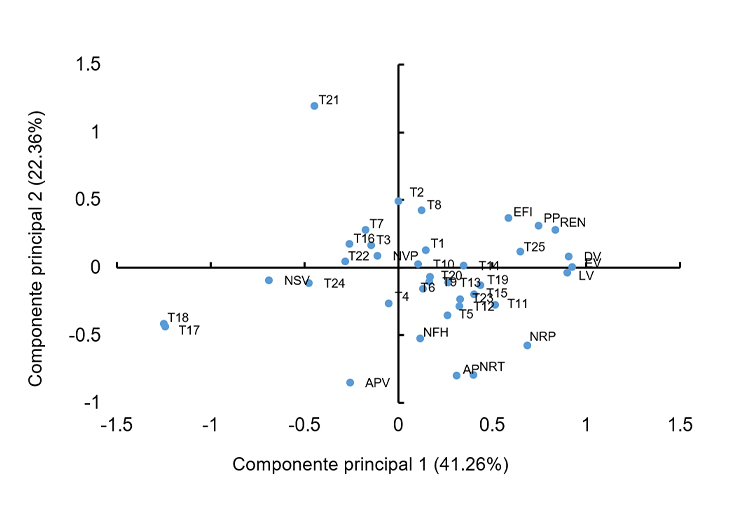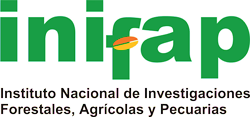Genetic variability and heritability in broad bean collections from central Mexico
DOI:
https://doi.org/10.29312/remexca.v16i6.3856Keywords:
Vicia faba L., green production, principal component analysisAbstract
This work was conducted with the aim of estimating variance components and broad sense heritabilities (H2) in quantitative and qualitative traits in 25 cultivars of broad beans using an experimental design of randomized complete blocks with four replications in a series of trials. The differences between the two environments (A), the 25 genotypes (G), and their interaction were significant for most of the traits evaluated. The highest H2 ranged from 51.73 to 96.68%. Principal component analysis accounted for 63.62% of the original total variation, yield was positively and significantly correlated with EFFI, NPP, PD, PL, WP, and YIE. The prediction with the GAM indicated that with NPP, PD, WP, and YIE, there would be greater genetic progress by selection. There was little phenotypic variability within each of the qualitative traits.
Downloads
References
Abo-Hegazy, H. S. R. E. 2022. Genetic variability, heritability and path coefficient analyses of some agronomic traits in faba bean (Vicia faba L.). Asian Journal of Plant Sciences. 21(1):469-474.
Amjad, Z. and Alghamdi, S. S. 2023. Agro-morphological characterization of Vicia faba L. accessions in the kingdom of Saudi Arabia. International Journal of Agricultural and Biosystems Engineering. 17(11):105-114.
Annicchiarico, P. and Iannucci, A. 2008. Breeding strategy for faba bean in Southern Europe based on cultivar responses across climatically contrasting environments. Crop Science. 48(3):983-991.
Arab, S. A.; Azza, F. S. and Marwa, K. A. M. 2018. Genetic diversity in some faba bean landraces using morphological characters and yield components. Journal of Plant Production. 9(12):975-980.
Baginsky, C.; Silva, P.; Auza, J. and Acevedo, E. 2013. Evaluation for fresh consumption of new broad bean genotypes with a determinate growth habit in central Chile. Chilean Journal of Agricultural Research. 73(3):225-232.
Chaudhary, A. K.; Nath, S.; Hitaishi, S. K. and Dutt, A. 2020. Assessing genetic variability, heritability and genetic advance in faba bean (Vicia faba L.) under sodic soil. Journal of Pharmacognosy and Phytochemistry. 9(5):966-970.
CONAGUA. 2014. Comisión Nacional del Agua. Servicio Meteorológico Nacional, Normales climatológicas. https://smn.conagua.gob.mx/es/climatologia/informacion-climatologica/normales-climatologicas-por-estado.
Díaz, B. M.; Herrera, C. B. E.; Ramírez, J. J.; Aliphat, F. M. y Delgado, A. A. 2008. Conocimiento campesino en la selección de variedades de haba (Vicia faba L.) en la sierra norte de Puebla México. Interciencia. 33(8):610-615.
Di Rienzo, J. A.; Casanoves, F.; Balzarini, M. G.; Gonzalez, L.; Tablada, M. y Robledo, C. W. 2008. InfoStat, versión 2008. Grupo InfoStat, FCA. Universidad Nacional de Córdoba, Argentina. 336 p.
Duc, G.; Bao, S. B.; Baum, M.; Redden, B.; Sadiki, M.; Suso, M. J.; Vishniakova, M. and Zong, X. 2010. Diversity maintenance and use of Vicia faba L. genetic resources. Field Crops Research. 115(3):270-278.
FAOSTAT. 2022. Food and Agriculture Organization of the United Nations. https://www.fao.org/faostat/es/#data/QCL.
Holland, J. B.; Nyquist, W. E. and Cervantes, M. C. T. 2003. Estimating and interpreting heritability for plant breeding: an update. Plant Breeding Reviews. 22(1):9-112.
Johnson, H. W.; Robinson, H. F. and Comstock, R. F. 1955. Genotypic and phenotypic correlation in soybean and their implication in selection. Agronomy Journal. 47(10):477-483.
Kosev, V. and Georgieva, N. 2023. Evaluation of the genetic diversity in broad bean (Vicia faba L.) accessions. Bulgarian Journal of Agricultural Science. 29(4):682-689.
Kumar, S.; Layek, S.; Upadhyay, A.; Pandit, M. K.; Nath, R. and Sarker, A. 2020. Genetic characterization for quantitative and qualitative traits and its relationship in faba bean (Vicia Faba L.). Indian Journal of Agricultural Research. 54(3):336-342.
Mohammed, O. A. A.; Hamid, A. A. and Bakheit, G. M. 2013. Correlation between seed yield components in faba bean (Vicia faba L.). Av. Environ. Biol. 7(1):82-85.
Pérez, L. D. J.; González, H. A.; Rubí, A. M.; Franco, M. O.; Franco, M. J. R. P. y Padilla, L. A. 2015. Análisis de 35 cultivares de haba por su producción de vaina verde y otros componentes del rendimiento. Revista Mexicana de Ciencias Agrícolas. 6(7):1601-1613.
Pérez, D. J.; González, A.; Sahagún, J.; Vázquez, L. M.; Franco, O. and Domínguez, A. 2009. The identification of outstanding potato cultivars using multivariate methods. Ciencia e Investigación Agraria. J. Agric. Nat. Res. 36(3):391-400.
Pérez, L. D. J.; Vázquez, G. L. M.; Sahagún, C. J. y Rivera, P. A. 2007. Variabilidad y caracterización de diez variedades de papa en tres localidades del Estado de México. Revista Chapingo Serie Horticultura. 13(1):13-19.
Rojas, T. J.; Díaz, R. R.; Álvarez, G. F.; Ocampo, M. J. y Escalante, E. A. 2012. Tecnología de producción de haba y características socioeconómicas de productores de Puebla y Tlaxcala. Revista Mexicana de Ciencias Agrícolas. 3(1):35-49.
Salazar, L. M. E.; Pérez, L. D. J.; González, H. A. y Vázquez, G. L. M. 2019. Variabilidad fenotípica en colectas de haba provenientes del Valle Toluca-Atlacomulco, México. Revista Mexicana de Ciencias Agrícolas. 10(3):713-727.
Sánchez, G. J. J. 1995. El análisis biplot en clasificación. Revista Fitotecnia Mexicana. 18(2):188-203.
SAS. 1988. Statistical Analysis System. SAS/STAT 9.1 User’s guide-release 9.01 edition Cary, NC. SAS Institute Inc.1861 p.
SIAP. 2022. Servicio de Información Agroalimentaria y Pesquera. https://nube.siap.gob.mx/cierreagricola/.
Shimelis, H. and Shiringani, R. 2010. Variance components and heritabilities of yield and agronomic traits among cowpea genotypes. Euphytica. 176(1):383-389.
SNICS. 2001. Servicio Nacional de Inspección y Certificación de Semillas. Guía técnica para la descripción varietal de haba (Vicia faba L.). 12 p.
Suso, M. J. and Maalouf, F. 2010. Direct and correlated responses to upward and downward selection for outcrossing in Vicia faba. Field Crops Research. 116(1):116-126.
Tadale, M.; Mohammed, W. and Jarso, M. 2022. Genetic diversity of elite faba bean (Vicia faba L.) genotypes based on agronomic traits and soil acidity stress indices. American Journal y Bioscience and Bioengineering.10(1):1-9.
Tadele, M.; Mohammed, W. and Jarso, M. 2021. Variation in genetic variability and heritability of agronomic traits in Faba bean (Vicia faba L.) genotypes under soil acidity stress evaluated with and without lime in Ethiopia. African Journal of Agricultural Research. 17(2):355-364.
Tekalign, A.; Derera, J. and Sibiya, J. 2020. Phenotypic diversity among faba bean (Vicia faba L.) landraces from the Ethiopian Highlands. Ethiopian Journal of Agricultural Sciences. 30(1):17-34.
Ton, A.; Karaköy, T.; Anlarsal, A. E. and Türkerí, M. 2021. Genetic diversity for agro-morphological characters and nutritional compositions of some local faba bean (Vicia faba L.) genotypes. Turkish Journal of Agriculture and Forestry. 45(3):301-312.
Yahia, Y.; Guetat, A.; Elfalleh, W.; Ferchichi, A.; Yahia, H. and Loumerem, M. 2012. Analysis of agromorphological diversity of southern Tunisia faba bean (Vicia faba L.) germplasm. Afr. J. Biotechnol. 11(56):11913-11924.

Published
How to Cite
Issue
Section
License
Copyright (c) 2025 Revista Mexicana de Ciencias Agrícolas

This work is licensed under a Creative Commons Attribution-NonCommercial 4.0 International License.
The authors who publish in Revista Mexicana de Ciencias Agrícolas accept the following conditions:
In accordance with copyright laws, Revista Mexicana de Ciencias Agrícolas recognizes and respects the authors’ moral right and ownership of property rights which will be transferred to the journal for dissemination in open access. Invariably, all the authors have to sign a letter of transfer of property rights and of originality of the article to Instituto Nacional de Investigaciones Forestales, Agrícolas y Pecuarias (INIFAP) [National Institute of Forestry, Agricultural and Livestock Research]. The author(s) must pay a fee for the reception of articles before proceeding to editorial review.
All the texts published by Revista Mexicana de Ciencias Agrícolas —with no exception— are distributed under a Creative Commons License Attribution-NonCommercial 4.0 International (CC BY-NC 4.0), which allows third parties to use the publication as long as the work’s authorship and its first publication in this journal are mentioned.
The author(s) can enter into independent and additional contractual agreements for the nonexclusive distribution of the version of the article published in Revista Mexicana de Ciencias Agrícolas (for example include it into an institutional repository or publish it in a book) as long as it is clearly and explicitly indicated that the work was published for the first time in Revista Mexicana de Ciencias Agrícolas.
For all the above, the authors shall send the Letter-transfer of Property Rights for the first publication duly filled in and signed by the author(s). This form must be sent as a PDF file to: revista_atm@yahoo.com.mx; cienciasagricola@inifap.gob.mx; remexca2017@gmail.
This work is licensed under a Creative Commons Attribution-Noncommercial 4.0 International license.


